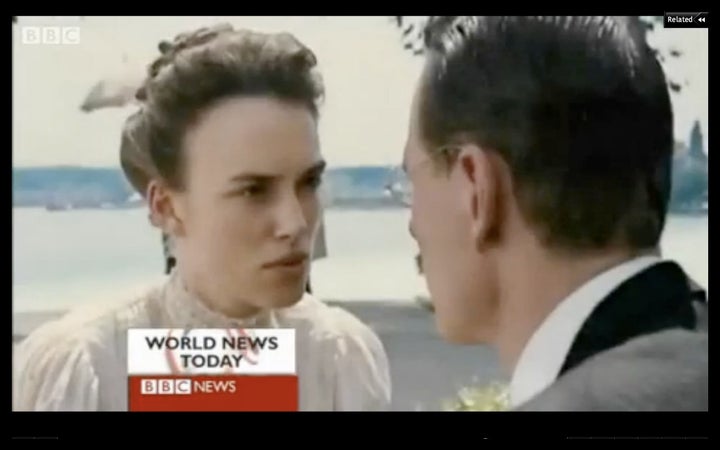
"All of David's movies are about the body," said producer Jeremy Thomas, when Cronenberg's new film A Dangerous Method screened at this year's New York Film Festival, "This time the body part is the brain." Given that the brain can be the sexiest organ, you can think of A Dangerous Method, based on a stage play by the screenwriter Christopher Hampton, as a love triangle with a twist: the players are the historic Carl Jung (Michael Fassbender) and Sigmund Freud (Viggo Mortensen), and their patient Sabina Spielrein (Keira Knightley), who became a writer and psychoanalyst in her own right. "They were incredible free thinkers," Thomas went on. "David could have made this material salacious but he handled it with delicacy."
I had visited David Cronenberg's set while he was making a film of William S. Burroughs's Naked Lunch, (1991) featuring physical metamorphoses as he had done in earlier films, The Fly (1986) and Videodrome (1983). He created creatures, Mugwumps and Talking Typewriters, the phantasmagoria of drug inspired mind trips. If Freud opened this door for people to go through, I was eager to talk to this filmmaker about this latest in a career-long fascination with the mind and where it can go. David Cronenberg unexpectedly revealed his anxiety of influence: Woody Allen.
Q: Your new film is full of "Cronenbergisms": body obsessions, kinky sex. Why did it take so long for you to get to this subject?
David Cronenberg: My first film was called Transfer -- seven minutes and in 16 mm -- about a psychiatrist and a patient. Psychoanalysis and Freud are monumental subjects; you really have to have a structure, a drama that crystallizes the material and period. I was looking for that, and then I read Christopher's play, The Talking Cure, and here was this beautiful structure and it had Sabina who I had never heard of. The play was Christopher's distillation to a five-character story that could deliver the texture and ethos of the times; these characters had the required charisma.
Q: Tell me about Keira Knightley as the pivotal character of Sabina. Frankly in the beginning, watching this beautiful actress in trauma is an excruciating experience. How did you direct her?
DC: We did a lot of research: Christopher had read Jung's papers on Sabina. We had seen films of people with hysteria, photographs in great detail. We knew what we were in for and that it would be difficult to watch. This hysteria was why Sabina could not function. Someone making those gestures is not presentable in society. So we had to decide how high to pitch it. As to the distortion of the face, I just said to Keira, "This is 'the talking cure': Sabina is been encouraged to speak unspeakable things, to say things she cannot say but she does want to say." When you see these people they have weird tics and body postures, it's like a self-mutilation. Distortions come around the mouth because you are trying to get the words out and distort them so they are not understandable. What you see is what Keira came up with. You can't have her come in and be morose or neurotic in a Woody Allen way. It has to be extreme.
Q: Is hysteria merely relegated to women? You give a glimpse of people who are hidden from society.
DC: They are now and they were then. Very disturbing. We don't think of hysteria as a disease anymore but the word does come from the Greek word for uterus. This was considered a woman's disease. They removed the uterus of women to cure them. It is irresistible to see this as the repression of women's sexuality, rampant in the Victorian era. Women were idolized as goddesses but they were meant to be beautiful, pure goddesses, not sexual or anything like that.
Q: Do you see Sabina Spielrein as a feminist icon?
DC: A feminist martyr. Christopher and I did not have an agenda or anything like that. We wanted to be as accurate as possible. We had lots of documentation because there was so much letter writing in that era. People were so obsessive they made notes about everything, conversations.
Q: Including about being tied up?
DC: No. Nothing like that.
Q: So that was your invention?
DC: An invention with justification. I was taken to task by a young woman who had seen the trailer. She was trying to convince me that Sabina and Jung never had sex. In her letters Sabina wrote about Jung in poetic terms, this woman claimed. You could have sexual poetry, I wanted to point out to her. But in her diary and letters to Freud, Sabina wrote, "I gave Jung my maidenhood, my innocence." In the Victorian era that could only mean one thing. They had a sexual affair. We coupled that with how she talked about her father and being beaten, how that turned her on sexually.
It's not exciting for Jung. He is not a sadist. As Otto Gross (Vincent Cassel) said to him, why not give her this simple pleasure. Why don't you just do it? What's the problem? Otto Gross did say that to Jung. If you know that, it is not far-fetched to think they had a little playtime S&M to exorcize her father from her sexuality, from her past, and of course Jung was a bit of a father figure as well. I don't think it is such a stretch. But no, that is true: there is no documentation that that occurred.
Q: Isn't the relationship between Jung and Freud like the Freudian paradigm played out?
DC: Jung did write to Freud to say, "You are my father figure." They could both see it, and still couldn't stop it from happening.
Q: I was moved by the coda, especially the line about Sabina, how she and her daughters were rounded up and shot in a synagogue. You get their vitality, and then their lives are snuffed out by war. Did you think of acting that out?
DC: It happened first in WWI, and for Sabina in WWII. So many brilliant people's lives were snuffed out by both of those wars. For Jews it was especially hard. In Christopher's play he has a flash forward to the moment when the Nazis kill her. He actually has that onstage. He had that in the script and I said the dramatist in me wants to do this but I think it would derange the movie. We want to play the movie from the characters' point of view and they don't know the future. It would take you into another time and she would have to be aged.
Q: What are you working on next?
DC: A movie with Paul Giamatti, based on a Don Delillo novel, Cosmopolis. It was shot a year after A Dangerous Method; it's me being Woody Allen, a film a year.
Q: Everyone must be asking you, were you ever in psychoanalysis?
DC: No.
Q: Why not?
DC: Because I have no problems, though I find it a fascinating relationship between a patient and an analyst. I do think it would be like taking antibiotics if you didn't have an infection. Why would you do that? People ask, is your movie making like therapy? No. Therapy is for when you have things in your life you want to resolve, to change. You go to work on them. Freud would have been shocked at Woody Allen. He never imagined 30 or 40 years of analysis. He was thinking three or four hours and you're done.
A version of this post also appears on Gossip Central.
